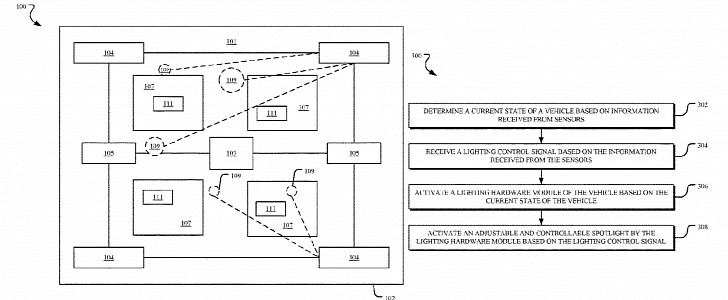Let’s be honest about it: the interior lights currently installed in our cars are pretty much useless, simply because finding something dropped on the floor at night is still impossible without actually turning to the flashlight feature of our phones.
Well, Apple too knows this is such a major struggle, so the company has developed an intelligent car interior light system that could make its way to the highly-anticipated Apple Car. It could finally be a useful feature that makes finding something in the cabin actually possible.
A patent called “system and method for adjustable lighting based on occupant and object identification in a vehicle” provides us with a closer look at everything. It pretty much reveals such a system would rely on an army of sensors and smart components that would work together to direct light exactly where you need it.
The system includes a dedicated chip and a lighting control signal unit that would receive information from the sensors to determine where it needs to send light. An adjustable and controllable spotlight would be installed in the car, though at first glance, there’s a chance Apple wants to use several of them to make sure it can even send light to hard-to-reach areas.
Apple admits in the patent document that the system currently installed on our cars comes with so many shortcomings.
“Conventional vehicle interior lights are static and typically vehicle occupants have to control the lights using a switch or a physical button. A conventional vehicle interior light may only illuminate a limited area while failing to illuminate large swaths of the interior of the vehicle,” the company says.
“As an example, the vehicle occupant may be attempting to find an object dropped onto the floor of the vehicle at night. When the occupant turns on a light mounted on the roof of the vehicle, the light may not be helpful because the occupant's body may create a shadow or the light may not illuminate a correct location within the vehicle. Objects within the vehicle also may be difficult to view based on limited lighting options in the interior of the vehicle.”
Of course, it’s important to keep in mind this idea is still in the patent stage for now, so only time will tell if Apple brings it to production cars or not.
A patent called “system and method for adjustable lighting based on occupant and object identification in a vehicle” provides us with a closer look at everything. It pretty much reveals such a system would rely on an army of sensors and smart components that would work together to direct light exactly where you need it.
The system includes a dedicated chip and a lighting control signal unit that would receive information from the sensors to determine where it needs to send light. An adjustable and controllable spotlight would be installed in the car, though at first glance, there’s a chance Apple wants to use several of them to make sure it can even send light to hard-to-reach areas.
Apple admits in the patent document that the system currently installed on our cars comes with so many shortcomings.
“Conventional vehicle interior lights are static and typically vehicle occupants have to control the lights using a switch or a physical button. A conventional vehicle interior light may only illuminate a limited area while failing to illuminate large swaths of the interior of the vehicle,” the company says.
“As an example, the vehicle occupant may be attempting to find an object dropped onto the floor of the vehicle at night. When the occupant turns on a light mounted on the roof of the vehicle, the light may not be helpful because the occupant's body may create a shadow or the light may not illuminate a correct location within the vehicle. Objects within the vehicle also may be difficult to view based on limited lighting options in the interior of the vehicle.”
Of course, it’s important to keep in mind this idea is still in the patent stage for now, so only time will tell if Apple brings it to production cars or not.

